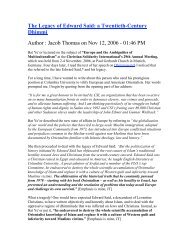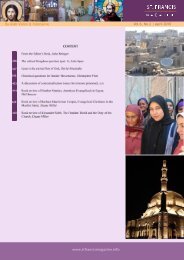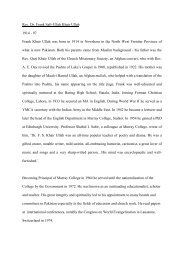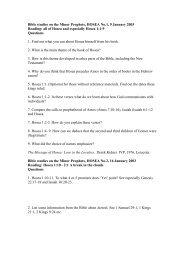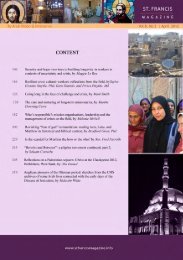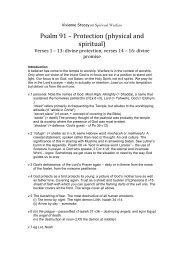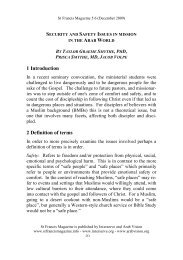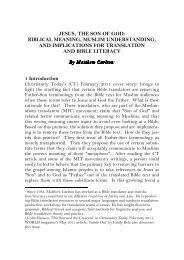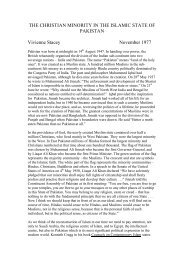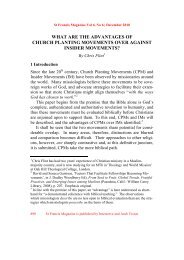download the pdf - St.Francis Magazine
download the pdf - St.Francis Magazine
download the pdf - St.Francis Magazine
Create successful ePaper yourself
Turn your PDF publications into a flip-book with our unique Google optimized e-Paper software.
<strong>St</strong> <strong>Francis</strong> <strong>Magazine</strong> Vol 8, No 4 | August 2012<br />
isolation. Can a believer in Christ survive without joining <strong>the</strong> flock<br />
Is it only through incorporation into a congregation of believers that<br />
a new social identity can emerge—one which will complement and<br />
complete <strong>the</strong> transformation in core identity<br />
Converts from Islam seek a new social identity, a new “family” to<br />
substitute for <strong>the</strong> old (especially if rejected by <strong>the</strong>ir own loved ones),<br />
a new role model of what it means to be Christ's follower, and a new<br />
pattern of Christian discipleship.<br />
Biblical <strong>the</strong>ology and <strong>the</strong> social sciences alike assert that <strong>the</strong> new<br />
community is essential for providing converts with <strong>the</strong> social identity<br />
<strong>the</strong>y crave. What, however, is to come of <strong>the</strong>ir old social identity, <strong>the</strong><br />
community in which <strong>the</strong>y were born and raised Will all links with<br />
that be cut off Is it necessary to have only one social identity, or can<br />
two be combined at <strong>the</strong> same time<br />
In fact many converts from Islam, to <strong>the</strong> extent that <strong>the</strong>y want to<br />
or are allowed to, maintain links of some kind with <strong>the</strong>ir Muslim<br />
families while simultaneously joining <strong>the</strong>ir new Christian “family”.<br />
Dual belonging is a reality for <strong>the</strong>m, and <strong>the</strong>y seek strategies to combine<br />
both social identities. So what circumstances allow coexistence<br />
and where is conflict inevitable When can twin loyalties be held<br />
side by side and when do <strong>the</strong>y tear a heart apart What local contextual<br />
variations bear on this, and what <strong>the</strong>ological insights help to<br />
chart a way through<br />
These questions are of urgent relevance to many thousands of<br />
Christians from Muslim background today. It is over <strong>the</strong>se questions<br />
that converts, national Christian leaders, missiologists and <strong>the</strong>ologians<br />
should pool <strong>the</strong>ir perspectives, not <strong>the</strong> old polarized Insider<br />
Movements debate which can never move forward until it recognizes<br />
<strong>the</strong> reality of dual social identity. I address this fur<strong>the</strong>r in section 6.2<br />
below.<br />
3.1.3 Conversion at <strong>the</strong> "Collective Identity" Level<br />
Collective identities of religion, ethnicity and nationality tend to get<br />
fused in traditional societies. So a person changing <strong>the</strong>ir religion is<br />
seen as betraying <strong>the</strong>ir family and <strong>the</strong>ir nation as well. Islamic histo-<br />
<strong>St</strong> <strong>Francis</strong> <strong>Magazine</strong> is a publication of Interserve and Arab Vision 530




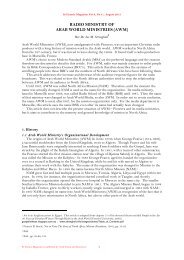
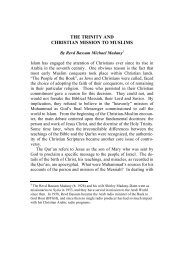
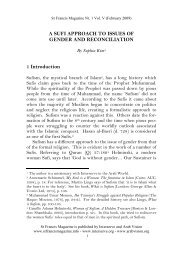
![Reflections on Surah Fatiha and the Lord's Prayer[1] - St.Francis ...](https://img.yumpu.com/49377951/1/184x260/reflections-on-surah-fatiha-and-the-lords-prayer1-stfrancis-.jpg?quality=85)
